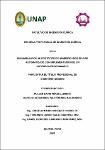| dc.contributor.advisor | Vásquez Pinedo, Jorge Armando | |
| dc.contributor.advisor | Salas Barrera, Fernando Javier | |
| dc.contributor.advisor | Carrasco Montañez, Daniel Diomedes | |
| dc.contributor.author | Pérez Llerena, Ruller David | |
| dc.contributor.author | Valderrama Maldonado, Karolin Alexandra | |
| dc.date.accessioned | 2025-07-16T14:13:28Z | |
| dc.date.available | 2025-07-16T14:13:28Z | |
| dc.date.issued | 2025 | |
| dc.identifier.other | 629.89 P45 2025 | |
| dc.identifier.uri | https://hdl.handle.net/20.500.12737/11592 | |
| dc.description.abstract | The general objective of this thesis was: to assemble a prototype of an automated air humidifier with the implementation of a programmable automaton, consisting of: an evaporator, a programmable logic controller, a temperature controller integrated with a sensor, a relative humidity controller integrated with a sensor, an extractor and an electric heater. This objective was achieved by designing and simulating a control circuit, considering the following order of connections in the programmable logic controller: the temperature and relative humidity sensors, the electric heater and the extractor, are connected to the inputs I3 and I4 and to the physical outputs Q1 and Q2, respectively. He results indicated that: if the water temperature (𝑇Water) is lower than the set point (80 °C), the temperature sensor contact (I3) closes, turning on the electric heater (Q1), demonstrating that there is an inverse relationship between Q1 and 𝑇Water. The evaporation rate of water changes in relation to temperature and time, from (0.000635 kg/s, 33.6 °C, 0 s) to (0.000669 kg/s, 81.8 °C, 780 s) and is constant (0.000666 kg/s) for values close to the set point (80 °C). If the relative humidity (𝐻𝑅Aire) is greater than the set point (95 %), the contact of the relative humidity sensor (I4) closes turning on the extractor (Q2), verifying that there is a direct relationship between Q2 and 𝐻𝑅Aire. In this way, the general objective was met and at the same time the general hypothesis was tested. | en_US |
| dc.description.abstract | El objetivo general de la presente tesis fue: ensamblar un prototipo de humidificador de aire automatizado con implementación de un autómata programable, conformado por: un evaporador, un autómata programable, un controlador de temperatura integrado a un sensor, un controlador de humedad relativa integrado a un sensor, un extractor y un calentador eléctrico. Dicho objetivo se logró, realizando el diseño y simulación de un circuito de control, considerando el siguiente orden de conexiones en el autómata programable: los sensores de temperatura y humedad relativa, el calentador eléctrico y el extractor, se conectan a las entradas I3 e I4 y a las salidas físicas Q1 y Q2, respectivamente. Los resultados indicaron que: si la temperatura del agua (𝑇Agua) es menor que el set point (80 °C), el contacto del sensor de temperatura (I3) se cierra prendiendo al calentador eléctrico (Q1), demostrando que existe una relación inversa entre Q1 y 𝑇Agua. La tasa de evaporación del agua cambia en relación con la temperatura y el tiempo, desde (0.000635 kg/s, 33.6 °C, 0 s) hasta (0.000669 kg/s, 81.8 °C, 780 s) y es constante (0.000666 kg/s) para valores cercanos al set point (80 °C). Si la humedad relativa (𝐻𝑅Aire) es mayor que el set point (95 %), el contacto del sensor de humedad relativa (I4) se cierra prendiendo al extractor (Q2), comprobando que existe una relación directa entre Q2 y 𝐻𝑅Aire. De esta forma, se cumplió el objetivo general y al mismo tiempo se ha probado la hipótesis general. | es_PE |
| dc.format | application/pdf | es_PE |
| dc.language.iso | spa | es_PE |
| dc.publisher | Universidad Nacional de la Amazonía Peruana | es_PE |
| dc.rights | info:eu-repo/semantics/openAccess | * |
| dc.rights.uri | https://creativecommons.org/licenses/by/4.0/ | * |
| dc.subject | Control automático | es_PE |
| dc.subject | Prototipos | es_PE |
| dc.subject | Control de la humedad | es_PE |
| dc.subject | Humedad relativa | es_PE |
| dc.subject | Controladores programables | es_PE |
| dc.title | Ensamblaje de un prototipo de humidificador de aire automatizado con implementación de un autómata programable | es_PE |
| dc.type | info:eu-repo/semantics/bachelorThesis | es_PE |
| thesis.degree.discipline | Ingeniería Química | es_PE |
| thesis.degree.grantor | Universidad Nacional de la Amazonía Peruana. Facultad de Ingeniería Química | es_PE |
| thesis.degree.name | Ingeniero(a) Químico(a) | es_PE |
| dc.subject.ocde | https://purl.org/pe-repo/ocde/ford#2.04.01 | es_PE |
| dc.subject.ocde | https://purl.org/pe-repo/ocde/ford#2.02.03 | es_PE |
| renati.author.dni | 71100339 | |
| renati.author.dni | 74322106 | |
| renati.advisor.orcid | https://orcid.org/0000-0002-8811-4832 | |
| renati.advisor.orcid | https://orcid.org/0000-0002-0177-3553 | |
| renati.advisor.orcid | https://orcid.org/0000-0002-2317-3911 | |
| renati.advisor.dni | 05221769 | |
| renati.advisor.dni | 05415003 | |
| renati.advisor.dni | 05339922 | |
| renati.type | https://purl.org/pe-repo/renati/type#tesis | es_PE |
| renati.discipline | 531026 | es_PE |
| renati.level | https://purl.org/pe-repo/renati/level#tituloProfesional | es_PE |
| renati.juror | Garcia Perez, Victor | |
| renati.juror | Malca Salas, Gustavo Adolfo | |
| renati.juror | Suarez Rumiche, Jorge Antonio | |
| dc.publisher.country | PE | es_PE |





